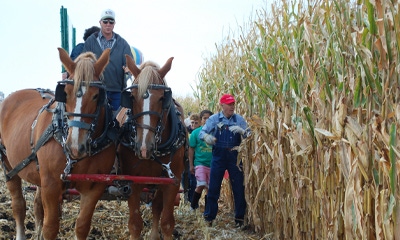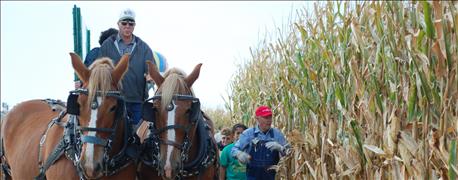August 16, 2016

Hand cornhusking might be a dying art, but the old-fashioned harvesting method will take center stage in Gothenburg this fall.
The Nebraska State Hand Cornhusking competition is slated for Sept. 17 from 9 a.m. to 3 p.m. at the Jim and John Hecox farm south of town. Organizers are looking for pickers, vendors and volunteers.
The Gothenburg Chamber Ag Com-mittee is hosting the event in conjunction with the town’s annual Harvest Festival, with assistance from the neighboring Cozad ag committee. The schedule includes a parade in town, a pancake feed, craft and food vendors, a children’s area, a pedal tractor pull and antique tractor displays at the farm.

HAND HUSKING: In 2008, a State Hand Cornhusking competition was held in York. Cornhusking contests held today involve a lot of preparation, including planting certain hybrids at specified spacing, lining up teams of horses and wagons, and finding volunteers.
“We are such an agriculturally centered community that it’s fun to step back and remember what it was like on the farm years ago,” says local rancher Shannon Peterson, who chairs the committee. “We’re really excited about our location and hope that it draws not only the ‘regulars,’ but also those who have never experienced hand cornhusking before.”
There are men’s and women’s divisions in each age bracket, ranging from youth, which is 14 and under, to the “golden age” of 75 and older. First-time pickers may register for the novice division.
Preregistration is $20, and the price moves to $25 the day of the event.
Volunteers needed
To learn more about how to participate or volunteer, or to reserve vendor space, call the Gothenburg Chamber at 308-537-3505. Or visit the Nebraska State Hand Cornhusking page on Facebook.
When Roland Lauer of Gothenburg “graduated from grade school” around 65 years ago, he started picking corn by hand. As he walked the rows in his father’s fields, there was some good-natured competition among the entire crew. They maybe even teased each other over who could pick the most or the best.
“We didn’t have hybrid corn, and one of the neighbors planted it,” the farmer says. “We picked for him and came home, and we demanded Dad plant hybrid corn.”
It made for easier picking and better corn. Decades later, hybrids were as commonplace as the combines that harvested the crop, but the sport of cornhusking was reinvigorated.
Lauer was surprised to find himself registered to compete in a formal contest. “My son signed me up,” Lauer says with a laugh. “I must have bragged about it a little too much.”
He went on to win, and even made time to travel to nationals on occasion. He credits his success to all the experience he gained growing up.
Similar stories could be repeated across the Midwest, as many of the oldest competitors today learned first on the farm. The earliest cornhusking contests got their start in the 1920s, says Dick Humes, 2015 national cornhusking historian.
“Henry Wallace would listen to the people come in and brag around the old store, when they were playing checkers or dominoes, about how much they’d picked in a day,” he says. “Finally, he said, ‘Let’s have a contest!’ ”
Eventually nine states allowed contestants to vie for two qualifying spots for nationals, and the large events drew crowds from across the country. Vendors set up, and it was the precursor to events like today’s Farm Progress Show.
“Of course, electricity was coming to the farm in the ’30s, and they’d bring washing machines and refrigerators and the gas stoves,” Humes says. “It was really quite a deal.”
But then, World War II and leaner times intervened. The 1942 contest was planned but never held.
Husking history relived
It may have gone down as a blip in the agricultural history books, if not for a couple of Kansas residents who decided to revive the sport as a way to draw interstate traffic. They held their first contest in 1971.
“Barring weather cancellations, Oakley [Kan.] has been hosting the Kansas State Cornhusking Contest the second weekend in October every year since,” says Laura Millensifer, of the town’s Buffalo Bill Cultural Center. “The contest is a way for us to share our heritage and agricultural history. The contest allows people to get in the field and see how it is done with horses and tractors and wagons. They can put on the hook and learn how it was done back in the day.”
At the same time the Living History Farm in Urbandale, Iowa, was doing the same, and today there are nine states involved again.
The same qualities that would’ve made somebody a good picker on a 1920s farm are the ones that will win a contest today.
“You got to be fast, but you’ve got to be clean,” Humes says.
During the allotted time, a judge and a gleaner follow a contestant with a bag. They pick up what’s missed and weigh that, issuing deductions for every left-on-the-ground pound. They also sample what’s picked and discount the husks.
“They didn’t want a dirty load of corn to go in the cribs,” he explains. “That’s one way they controlled rodents, because there wasn’t anything for them to hide in except corn, and they wanted something to make a nest out of.”
Today, state hand cornhusking contests involve a lot preparation: planting certain hybrids at specified spacing, lining up teams of horses and wagons, and gathering volunteers. Still, people in towns like Gothenburg, Neb., are happy to help. They’ll host the state’s competition Sept. 17, and the volunteer work helps families to continue the tradition.
Four of Lauer’s grandchildren regularly participate. “They like to compete against each other,” he says.
It’s a sport that spans generations, and keeps one connected to the other. Simply put: “It’s a good challenge,” Lauer says.
Source: Gothenburg Chamber Ag Committee
You May Also Like




